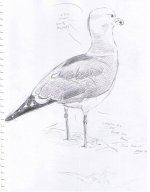colleenc
Well-known member
good idea Sid,
When I saw his sketchbook at Birds in Art one bird actually not even the whole bird filled a page and spilled over to the next one, bigger than lifesize, It was some sort of duck....But I have to keep remembering he is doing this after long years of making art for field guides and drawing after precise drawing, so he knows the basic forms they take already, and besides that he is so huge that one of his hands equals almost 2 of mine...
If you figure out how to draw bigger let me know, or maybe one of the guys ( I use that generically not genderly) will give us a clue.
When I saw his sketchbook at Birds in Art one bird actually not even the whole bird filled a page and spilled over to the next one, bigger than lifesize, It was some sort of duck....But I have to keep remembering he is doing this after long years of making art for field guides and drawing after precise drawing, so he knows the basic forms they take already, and besides that he is so huge that one of his hands equals almost 2 of mine...
If you figure out how to draw bigger let me know, or maybe one of the guys ( I use that generically not genderly) will give us a clue.




